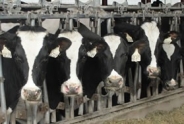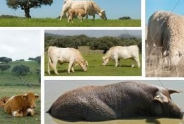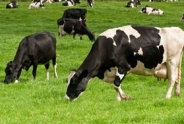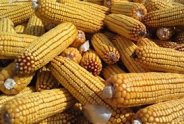NNYADP Research:
Canton, New York. The results of a Northern New York Agricultural Development Program (NNYADP) research project in 2021 demonstrate how fluctuating grain costs may impact sheep enterprises differently from year to year.
Research comparing the growth of barn-fed versus pasture-raised summer lambs was designed to answer sheep producers' questions on whether they could gain any income advantage with a feeding program that would make lambs ready for market more quickly. An informal trial in 2020 that favored pasture feeding but highlighted many data variables prompted this second trial that produced data favoring barn-fed lambs, demonstrating the annual variability.
The results of the summer lambs feeding trial conducted at the Cornell Cooperative Extension Learning Farm in Canton, New York, are posted on the NNYADP website at https://www.nnyagdev.org.
Forty-one lambs were split into two groups in the spring of 2021 with one group left on pasture with mother ewes and one group weaned at eight weeks into a barn environment and eased into a full-grain diet. The lambs in each group were periodically weighed, monitored for parasites, and treated when warranted.
At the end of the eight-week study period, the barn-fed lambs weighed 19.24 pounds more than the pasture-fed lambs.
Based on this weight and the per-pound sale price for lambs in the fall of 2021 at the New Holland, Pennsylvania, sale barn, the weight difference in the barn-fed lambs represented a gross income potential for $52 more per lamb. This number less the extra cost for 161 pounds of grain fed per lamb represented a net income of $15.40 per lamb over the cost of grain in 2021.
The final project report also details other costs and management factors that need to be considered in planning a summer lamb feeding strategy. These considerations include the costs of mineral supplementation, for parasite prevention and treatment, and for losses to predators, as well as fuel and labor costs associated with clipping pastures and moving fences to rotate grazing areas.
Over the eight-week study period, the average daily weight gain (ADG) of the barn-fed lambs ranged from 0.70 to 1.04 pounds per day; the ADG of the pastured lambs ranged from 0.13 to 0.83 pounds per day.
In a two-week extended trial period, the ADG for the barn-fed lambs was 0.58 pounds per day compared to 0.92 pounds per day for the pastured lambs that had been weaned and brought into the barn and fed approximately one pound per day of the barn-fed lambs' grain diet and all the hay they could eat.
Cornell University graduate student Hannah Braun of Lisbon, New York, handled data collection and management of the barn-fed lambs as part of her honors thesis development.
Funding for the Northern New York Agricultural Development Program is supported by the New York State Legislature through the New York State Assembly and administered by the New York State Department of Agriculture and Markets. NNYADP project results are publicly accessible at https://www.nnyagdev.org.
MEDIA CONTACTS: . NNYADP Co Chairs: Jon Greenwood, 315-386-3231; Joe Giroux, 518-563-7523; Jon Rulfs, 518-572-1960 . NNYADP Coordinator Michele Ledoux: 315-376-5270, mel14@cornell.edu . Publicist Kara Lynn Dunn: 315-465-7578, karalynn@gisco.net
Upcoming Events
Winter Bale Grazing Pasture Walk
January 10, 2026
Truxton, NY
Join us for the second Bale Grazing Winter Pasture Walk!
Have you heard about or seen bale grazing and wondered if it would work for you?
Do you want to learn the nuances and logistical context for implementing this regenerative practice?
Are you interested in seeing the impacts of bale grazing on land and animals from a practicing farmer?
If you answered Yes to any question, The Northeast Region National Grazing Lands Coalition, the Cornell Cooperative Extension Hillside Farms are teaming up to showcase our Second Bale Grazing Winter Pasture Walk!
Boots in the Barn: Webinar Series
January 13, 2026
Boots in the Barn: Cornell Dairy Research Updates
Webinar Series every Tuesday starting January 13th @ 12:00pm to February 24th.
2026 Winter Crop Meeting
January 22, 2026
Auburn, NY
Connect with the agricultural community and many key note speakers on the folllowing topics:
- Emerging Innovation in Plant Breeding and Technologies - A Peek at the Future by Ben Rogers, Pioneer Field Agronomist
- Managing Herbicide-Resistant Weeds in NY Corn & Soybean by Dr. Vipam Kumar, NYS Extension Weed Scientist, Cornell University
- Livestock Risk Protection (LRP) Insurance Program by KC Slade, Risk Management Specialist, Farm Credit East—Crop Growers
- Birds & the Bees Legislation and the Fate of Neonics by Janice Degni, Extension Field Crop Specialist
- Emerging Disease Pests and Soil Borne Diseases of Soybean by Dr. Camilo Parada Rojas, NYS Extension Plant Pathologist, Cornell University
- Solar Farms—Benefit or Detriment? by Mr. Michael McMahon, Chair, Homer Town Planning Board
4 DEC credits in categories 1A and 21-25. 1.5 PM, .5 CM and 1 PD CCA credits available.
Please send your DEC license number in the Notes to Us when you register on-line.
Announcements
USDA Contract Freezes and Terminations: Legal Action Steps for Farmers
For Farmers with Signed EQIP and CSP ContractsThis resource is written for farmers and ranchers nationwide who have a signed contract with USDA NRCS under the EQIP or CSP program for environmental improvements but have concerns that their contract is frozen, under review, or terminated, and who are uncertain of their rights to receive reimbursement as well as their ongoing obligations under the signed contract.
Version: 1.0
Issue date: Feb 28, 2025
A downloadable factsheet is available at our BUSINESS tab on the top of our webpage.
Additional Information: www.farmcommons.org
USDA Contract Freezes: Filing an NAD Appeal or Demand Letter
This resource is written for farmers and ranchers nationwide who have a signed contract with USDA NRCS under the EQIP or CSP program for environmental improvements and want more information on the mechanics of filing a National Appeals Division (NAD) appeal. This resource includes sample letters.
USDA NAD Appeal https://www.usda.gov/about-usda/general-information/staff-offices/office-hearings-and-appeals/national-appeals-division/nad-appeals
Farm Participants Needed for Bale Grazing Grant!
Information on the Project:- Approximately 10 acres total needed to bale graze two different bale densities
- "Core" farms will graze two winters, "Demo" farms will graze one winter.
- Payments for both "Core" farms and "Demo" farms
- Baseline soil sampling by bale grazing team
- Forage measurements in early season by bale grazing team
- Late season clipping if residual not trampled down by farm
Cornell Cow Convos - New Podcast
On-going podcast, New episodes released on the last Thursday of the month.Guest speakers, CCE Dairy Specialists.
Housed on Soundcloud Channel is CCE Dairy Educators
- Preventative healthcare for cows
- The trend of beef on dairy
- What to look forward to in the new year for dairy
- Socially grouping or pair-housing calves
2018 Drug Residue Prevention Manual
For more than 30 years, the U.S. dairy industry has focused educational efforts on the judicious use of antibiotics through the annual publication of a Best Practices Manual. The 2018 edition of the National Dairy FARM Program: Farmers Assuring Responsible Management? Milk and Dairy Beef Drug Residue Prevention Manual is the primary educational tool for dairy farm managers throughout the country on the judicious and responsible use of antibiotics, including avoidance of drug residues in milk and meat.The manual is a quick resource to review those antibiotics approved for dairy animals and can also be used as an educational tool and resource for farm managers as they develop on-farm best management practices necessary to avoid milk and meat residues. Visit the Manual and Form Library to download copies of this important tool!
Follow us on Facebook
The team updates our facebook page frequently - follow us to be updated on our events, see some fun videos and get local area updates!facebook.com/SCNYDairyandFieldCropsTeam
NYSERDA Agriculture Energy Audit Program
NYSERDA offers energy audits to help eligible farms and on-farm producers identify ways to save energy and money on utility bills. Reports include recommendations for energy efficiency measures.For more information and the NYSERDA Agriculture Energy Audit Program Application click here





